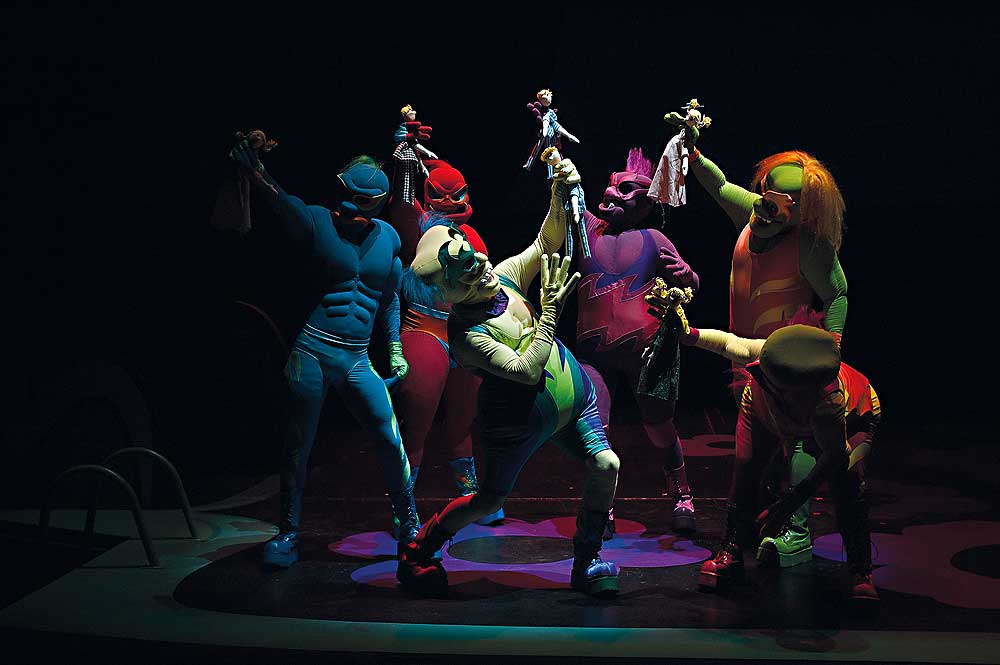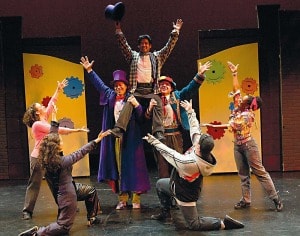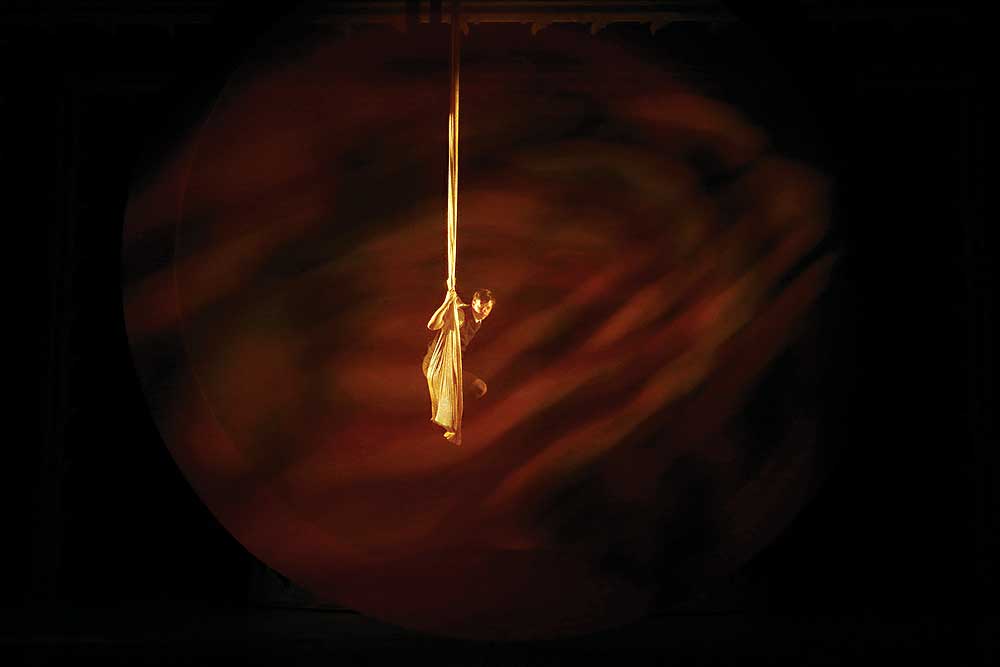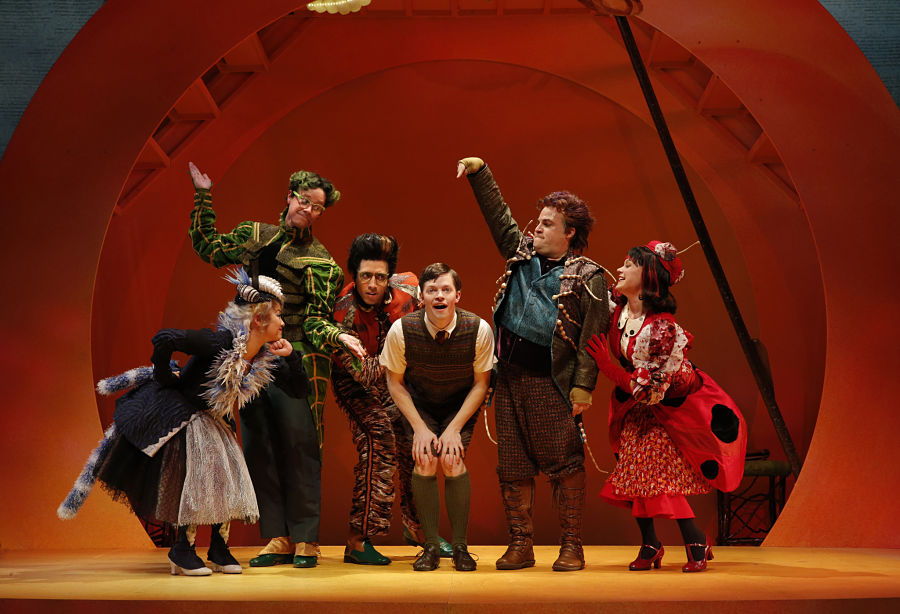“Most of the really exciting things we do in our lives scare us to death. They wouldn’t be exciting if they didn’t.” —Roald Dahl, Danny, the Champion of the World
If you want to get a child’s attention, the first thing to do is get rid of Mom and Dad.
That’s according to Roald Dahl, the deliciously dark author who has delighted children of all ages for years with his devilishly imaginative tales.
“He changed the face of children’s literature completely,” says Tim McDonald, the CEO of iTheatrics, a New York City–based organization that develops musicals for young audiences. “Dahl’s technique was to scare kids right at first, and eliminate the parents, so now it’s them and the storyteller—then you can go anywhere.”
And he did—from an escaped rhino devouring the title character’s parents in James and the Giant Peach, to a land of giants who eat children in The BFG, to the halls of a school where the headmistress operates a veritable torture chamber in Matilda, to a magical candy lair where greedy children almost meet their demise in tubes of sugar in Charlie and the Chocolate Factory. And now Dahl’s going somewhere else: the stage.
Contemporary adaptations of Dahl are commanding attention at venues in the U.S. and abroad ranging from children’s theatre companies to Broadway, and in varying formats, from straight plays performed in schools, to large-scale commercial musicals, to an opera.
British playwright David Wood was one of the first to make the leap—he has adapted eight of Dahl’s novels into plays for children. And iTheatrics’s McDonald more or less led the musical-theatre charge, creating the first official musical adaptation of a Dahl work—Willy Wonka, inspired by the 1971 film, co-written with the film’s composer, Leslie Bricusse, and using songs from the movie. McDonald followed up with a James and the Giant Peach musical, written with Tony-nominated songwriters Benj Pasek and Justin Paul. James had its world premiere at Connecticut’s Goodspeed Opera House in 2010; a retooled version was presented at Seattle Children’s Theatre in 2013; and it will be performed this season at Alliance Theatre in Atlanta and Nashville Children’s Theatre.
The Royal Shakespeare Company launched its energetic musical staging of Matilda as its 2010 holiday show, and, four years later, the show continues to attract multi-generational audiences in the West End and on Broadway. Following Matilda came Warner Brothers Theatre Ventures’s Charlie and the Chocolate Factory, with music by the Tony-winning duo Marc Shaiman and Scott Wittman and book by David Greig, which has been running in London for more than a year. In September, Opera San Antonio presented Tobias Picker and Donald Sturrock’s Fantastic Mr. Fox opera, and this spring, Enda Walsh and John Tiffany, of Once fame, will deliver Walsh’s (non-musical) adaptation of The Twits at the Royal Court Theatre in London.
It’s a very Dahlian moment, indeed.
“There’s something rather magical about Dahl,” says Wood, noting that the Welsh-born British author, who died in 1990, was a multifaceted figure, known as a novelist, short-story writer, poet, fighter pilot and screenwriter as well as for his enduring contribution to children’s lit. “The situations in his tales are larger than life, and you often have a child as the protagonist—and that child is often the underdog who triumphs through adversity. That is a very good, very theatrical way of telling a story.”
Dahl released James and the Giant Peach, his first major children’s work, in 1961, the same year as Norton Juster’s The Phantom Tollbooth and just two years before Maurice Sendak’s Where the Wild Things Are, ushering in a new era of darkness in children’s fiction. Not unlike those authors, Dahl took many of his tropes from classics.
“In James and the Giant Peach, there’s the whole idea of the peach growing—it’s very much like Jack and the Beanstalk,” suggests Wood. “And you can find parallels to Cinderella, with the two unpleasant stepmothers being very similar to Aunt Spiker and Aunt Sponge in James. He uses classic ingredients and contemporizes them.”
And now many point to Dahl as the precursor for modern series like Harry Potter, A Series of Unfortunate Events, The Hunger Games and A Tale Dark & Grimm, all of which contain ominous themes, from magic to murdering teenagers.
“You have to look to Matilda a little bit to see the origins of Harry Potter, I reckon,” concurs Tim Minchin, who wrote the music and lyrics for the Matilda musical. “It has a hero with great odds stacked against her, who, through nothing but books and reading and the power of her own incredible brain, sort of vanquishes everyone. We love stories about genius and stuff.”
At their core, these Dahl stories are written for a young readership, though they may actually stem from gloomy adult concerns, sometimes personal ones for the author. When Dahl started writing James and the Giant Peach, for example, he penned much of it in a hospital waiting room after his son’s baby carriage had been hit by a car.
“He’s really using fantasy as a coping mechanism for those things that happen to us in life,” reasons Ernie Nolan, producing artistic director of Chicago’s Emerald City Theatre, where The BFG in running through Jan. 4, 2015. “There’s something so amazing about sharing those kinds of survival stories with young people, and dealing with those dark elements that young people are able to overcome.”

Still, the notion of rhinos eating moms and dads or giants devouring innocent children is far tamer on the page than when such actions come to life on the stage—and when McDonald was working on James and the Giant Peach at Seattle Children’s Theatre, he was unsure whether the scary opening would work for young audiences.
“Just a loud clap of thunder can startle a kid, and once they start crying, you’ve lost them for the show,” McDonald points out. “So how do you balance that? And not do it in a way so that the older kids are going, ‘That’s stupid!’—and in a way that means that the parents in the audience are getting another message.”
The show’s opening involved James dreaming about the rhino incident, with the beast embodied by a large puppet. In case that beginning proved to be too frightening in early previews, McDonald, Pasek and Paul had alternatives in mind. However, there didn’t end up being any issue.
“Watching kids in the theatre, you discover that the parts that you think will be very scary to them are the parts when they lean in the most,” says Pasek.
When Wood was adapting The Twits, about a nasty couple who torture monkeys, among other things, he struggled with making things that seem funny on the page seem equally funny in action. He came across a line in the book about Mr. and Mrs. Twit living in the circus, and he suddenly thought, “Let’s set the whole thing in the circus! That way we can use clowning techniques legitimately—and it means that we can make some of the physical stuff, which is really quite unpleasant if you do it for real, more slapstick.”
Wood says that American audiences have tended to be more skeptical than the British of Dahl’s penchant for the dark side—though reactions have gotten better over the years. When The BFG was first done stateside, “There were worries about making the giants too frightening,” he explains. “The tendency was to make them a bit too colorful, and when they came on they were almost a bit jolly, and that slightly worried me.” Wood recounts that during a production of The BFG at Dallas Children’s Theater, a teacher escorted her class out of the theatre and told them, “Face the wall and pray for forgiveness.” When the front-of-house manager inquired as to what was wrong, the teacher pointed back to the auditorium and shouted “Giants! Giants!” “There was this feeling that giants are things of evil,” Wood explains. “I’m not trying to make it sound as though in the UK everything is more advanced, because there were similar reservations about Dahl here. He was not a recommended author in schools or on reading lists for many years.”
Things have changed, though, Wood says, and he cites productions of The BFG at Children’s Theatre Company of Minneapolis and at Philadelphia’s Arden Theatre Company as two of the best he’s ever seen.
For his part, Minchin posits that reservations about Dahl in the U.S. could have something to do with cultural differences. “The broader American tropes are about hope—they are aspirational,” Minchin says, while “Britain’s a bit more post-colonial and a bit more self-flagellating. There is a tiny percentage of the American audience that is like, ‘Hold on, you’re making us feel conflicted.’ It’s never the little kids who find it dark—they find it hilarious and fun. It’s always some 50-year-old who wants a Mars Bar of a show. The kids never have a problem with the complexity.”
Darkness isn’t the only obstacle in adapting Dahl’s work. His writing style is very episodic, Minchin points out, as his children’s books were designed to be read a chapter at a time at bedtime, and many of the books feature a quiet, passive child as the central character. This might work well in print, where the stories’ crazy, chaotic worlds keep the reader’s attention, but it doesn’t provide a lot of dramatic energy for the stage. In Matilda, Minchin initially had trouble finding a way to make the title character sing, and even considered making her a nonsinging character.
“Deciding who sings what where is the great challenge of writing musical theatre,” declares Minchin. “Some people don’t seem to want to sing, so getting Matilda to sing at all was tough, because we didn’t want her to be Annie. She’s a quiet reader, but she’s got guts.” Matilda’s first song, “Naughty” (which is essentially a repurposing of the show’s second-act opener, “When I Grow Up,” set to a different tune with the same harmonic basis), was the last thing Minchin wrote for the production.

While Shaiman and Wittman didn’t have trouble getting Charlie to sing, they did struggle with making him a more dynamic character. “Charlie is more or less a witness in the story,” Wittman elaborates. “That doesn’t necessarily work onstage—he has to be part of the action of things. When a story is so well known, as it is in London, where the book is part of the kids’ DNA, they know what’s going to happen, and they’re very attentive. The trick is to surprise them when it does happen.”
While Matilda has somewhat of a cathartic journey, moving from being an ill-cared-for-yet-brilliant child to one who is well loved and looked after, both Charlie and James, in their respective worlds, just stumble along. Charlie starts well loved and ends up well loved, inheriting a chocolate factory along the way; James just happens to meet a mysterious man who supplies him with the magic that’s crucial to his future.
When it came to musicalizing the latter character’s story, however, Pasek and Paul found that embellishing the wacky world actually created more problems. “When we tried to take something that was bizarre and make it sound really bizarre, we found we were taking things too far,” Paul concedes. “What’s there is already so quirky and different and atypical that sometimes we needed to serve it up as it was, and not try and make some sort of even more bizarre refraction of it.”
Shaiman had his own problems with Charlie and the Chocolate Factory: Two films and the TYA Willy Wonka already existed, so the proliferation of adaptations could muddy the mind, thanks to one song in particular. “So many people feel like that movie is their Wizard of Oz,” allows Shaiman, noting that the song “Pure Imagination” is omnipresent. “Even our best friends who knew better would say to us, ‘Oh, is “Pure Imagination” going to be in it?’ So after a while it became clear it would be foolhardy to not include it.”
Education is an important aspect of Dahl’s work, and that’s another reason for its growing popularity at children’s theatres across the country.
“The cross-curricular opportunities are ripe with Dahl’s work,” enthuses Nolan, who says he loves working with schools and theatre education departments to come up with lesson plans. “With a piece like James and the Giant Peach, sure, there are English and language arts things you can do with it—but the material lends itself to sharing questions with students like, What’s a fruit? How does a fruit grow? There’s a geography lesson, since they go all the way from the UK to NYC. There’s even a discussion of map-reading. They cross a body of water. There’s a discussion of insects.”

Wood has adapted his longer Dahl plays, which are intended to be performed by adults for children, into playlets (published by Puffin Books, an imprint of Penguin) that are built for large casts of schoolchildren to perform. “It’s a very good way of encouraging children to read,” Wood says. “If you’re reading a play, embodying the different characters and having conversations with other people who are playing other parts, it becomes more of a communal experience. It’s more fun, and learning to read should be fun, for heaven’s sake.”
Another thing that makes Dahl a good fit for today’s young audiences is the fact that many modern parents grew up on Dahl’s stories and are excited about introducing them to their children. Nolan calls parents and teachers the “gatekeepers” for TYA audiences, and the box office for at a children’s theatre is typically split between four-to-five school-sourced shows during the week and three-to-four shows for family audiences on weekends. “We produce work for an audience that doesn’t buy the tickets—they may have a passion level, but they’re an audience who can’t drive themselves to the theatre. So when the work does have multigenerational appeal, or that memory factor for the parents, or when a teacher can open up that book in the classroom as part of the curriculum, it’s important for us—that’s how we can put butts in seats.”
Though Dahl is proving popular onstage, the man himself was not a fan of adaptations of his work. Dahl died just months before Wood’s BFG premiered in England, and there were two prior stage adaptations of Dahl’s books that he killed, the playwright notes. “I remember Tessa Dahl, his daughter, saying to me years later, ‘You were very lucky that Daddy died when he did—he probably wouldn’t have liked your adaptations any more than anybody else’s,’” Wood recalls.
With so many adaptations circulating the market at the moment, the Dahl estate is alert about maintaining the brand and deciding whether a particular project is right for the theatre. “There’s a difference between saying, ‘Does this story belong onstage?’ as opposed to, ‘Oh, people love Dahl, let’s put it onstage,’” Minchin says. “The stories are wonderful, but there are great challenges in making sure you don’t lose their inherent Dahl-ness when you change the format.”
And the fact that a book has already been adapted doesn’t mean there can’t be yet another iteration. While Wood’s and McDonald’s adaptations are built for children, the big Broadway and commercial shows based on the same material are quite different. There are also several film adaptations coming up, adding to the existing Dahl canon: Willy Wonka & the Chocolate Factory, Tim Burton’s Charlie and the Chocolate Factory, Danny DeVito’s Matilda, The Witches and Wes Anderson’s Fantastic Mr. Fox. Steven Spielberg is slated to take on The BFG, and Guillermo del Toro’s Witches remake is in the works. This proliferation of Dahl on screen may mean the plays will be staged even more often.
“They wouldn’t stop selling the book because the film’s coming out, so it would be rather odd to have people stop doing the play,” figures Wood, adding that no fewer than six regional theatres in and around London are doing his plays this holiday season. “If you’re a playwright writing for adults, there aren’t that many who achieve the longevity whereby their plays are put on regularly for years and years,” Wood says, citing Mamet, Miller, Pinter and Stoppard. “Children’s plays don’t seem to date as much.”
Though the royalty percentage is different, as costs are kept low and runs are kept short, Wood says that’s as it should be. “There is still this slight stigma about creating work for children, which is ironic, really, because children are the future—and one would think the theatre profession in general would appreciate the importance of children’s theatre,” Wood goes on. “I don’t get as much of a buzz from anything I do as from standing in the back of an auditorium full of children reacting favorably and un-cynically and becoming totally immersed in the play. As long as I keep getting that buzz, I’ll continue.”


